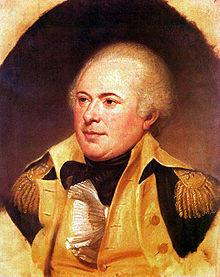
Little Turtle was a Sagamore (chief) of the Miami people, who became one of the most famous Native American military leaders. Historian Wiley Sword calls him "perhaps the most capable Indian leader then in the Northwest Territory," although he later signed several treaties ceding land, which caused him to lose his leader status during the battles which became a prelude to the War of 1812. In the 1790s, Mihšihkinaahkwa led a confederation of native warriors to several major victories against U.S. forces in the Northwest Indian Wars, sometimes called "Little Turtle's War", particularly St. Clair's defeat in 1791, wherein the confederation defeated General Arthur St. Clair, who lost 900 men in the most decisive loss by the U.S. Army against Native American forces.

The Miami are a Native American nation originally speaking one of the Algonquian languages. Among the peoples known as the Great Lakes tribes, they occupied territory that is now identified as north-central Indiana, southwest Michigan, and western Ohio. The Miami were historically made up of several prominent subgroups, including the Piankeshaw, Wea, Pepikokia, Kilatika, Mengakonkia, and Atchakangouen. In modern times, Miami is used more specifically to refer to the Atchakangouen. By 1846, most of the Miami had been forcefully displaced to Indian Territory. The Miami Tribe of Oklahoma are the federally recognized tribe of Miami Indians in the United States. The Miami Nation of Indiana, a nonprofit organization of descendants of Miamis who were exempted from removal, have unsuccessfully sought separate recognition.

Josiah Harmar was an officer in the United States Army during the American Revolutionary War and the Northwest Indian War. He was the senior officer in the Army for six years and seven months.

The Northwest Territory, also known as the Old Northwest and formally known as the Territory Northwest of the River Ohio, was formed from unorganized western territory of the United States after the American Revolutionary War. Established in 1787 by the Congress of the Confederation through the Northwest Ordinance, it was the nation's first post-colonial organized incorporated territory.

The Battle of Fallen Timbers was the final battle of the Northwest Indian War, a struggle between Native American tribes affiliated with the Northwestern Confederacy and their British allies, against the nascent United States for control of the Northwest Territory. The battle took place amid trees toppled by a tornado near the Maumee River in northwestern Ohio at the site of the present-day city of Maumee, Ohio.
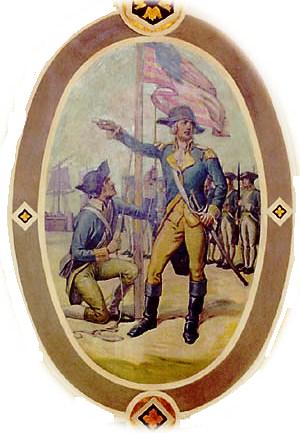
Jean-François Hamtramck (1756–1803) was a Canadian who served as an officer in the US Army during the American Revolutionary War and the Northwest Indian War. In the Revolution, he participated in the Invasion of Quebec, the Sullivan Expedition, and the Siege of Yorktown. In the history of United States expansion into the Northwest Territory, Hamtramck is connected to 18th century forts at modern Midwest cities such as Steubenville, Vincennes, Fort Wayne, and Detroit. The city of Hamtramck, Michigan is named for him.
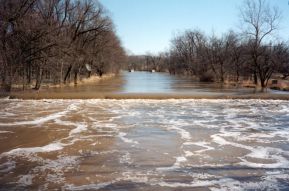
The Eel River is a 94-mile-long (151 km) tributary of the Wabash River in northern Indiana in the United States. Via the Wabash and Ohio rivers, its waters flow to the Mississippi River and ultimately the Gulf of Mexico. The Eel River rises southeast of Huntertown in Allen County and flows southwest through Allen, Whitley, Kosciusko, Wabash, Miami, and Cass counties to join the Wabash at Logansport. The river was called Kineepikwameekwa Siipiiwi - "river of the snake fish" by the Miami people, who inhabited the area at the time of European contact, the English rendered it as Ke-na-po-co-mo-co. It is the northern of the two rivers named Eel River within Indiana.
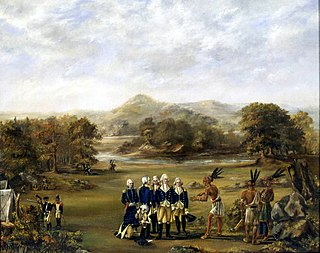
The Northwest Indian War (1785–1795), also known by other names, was an armed conflict for control of the Northwest Territory fought between the United States and a united group of Native American nations known today as the Northwestern Confederacy. The United States Army considers it the first of the American Indian Wars.

William Wells, also known as Apekonit, was the son-in-law of Chief Little Turtle of the Miami. He fought for the Miami in the Northwest Indian War. During the course of that war, he became a United States Army officer, and also served in the War of 1812.

The Legion of the United States was a reorganization and extension of the United States Army from 1792 to 1796 under the command of Major General Anthony Wayne. It represented a political shift in the new United States, which had recently adopted the United States Constitution. The new Congressional and Executive branches authorized a standing army composed of professional soldiers rather than relying on state militias.
Fort Miami, originally called Fort St. Philippe or Fort des Miamis, were a pair of French built palisade forts established at Kekionga, the principal village of the Miami. These forts were situated where the St. Joseph River and St. Marys River merge to form the Maumee River in Northeastern Indiana, where present day Fort Wayne is located. The forts and their key location on this confluence allowed for a significant hold on New France by whomever was able to control the area, both militarily for its strategic location and economically as it served as a gateway and hotbed for lucrative trade markets such as fur. It therefore played a pivotal role in a number of conflicts including the French and Indian Wars, Pontiac's War, and the Northwest Indian War, while other battles occurred nearby including La Balme's Defeat and the Harmar campaign. The first construct was a small trading post built by Jean Baptiste Bissot, Sieur de Vincennes around 1706, while the first fortified fort was finished in 1722, and the second in 1750. It is the predecessor to the Fort Wayne.

Augustin Mottin de La Balme was a French cavalry officer who served in Europe during the Seven Years' War and in the United States during the American Revolution. His attempt to capture Fort Detroit in 1780 ended in defeat when he was ambushed by forces under Chief Little Turtle.
Ouiatenon was a dwelling place of members of the Wea tribe of Native Americans. The name Ouiatenon, also variously given as Ouiatanon, Oujatanon, Ouiatano or other similar forms, is a French rendering of a term from the Wea dialect of the Miami-Illinois language which means "place of the people of the whirlpool", an ethnonym for the Wea. Ouiatenon can be said to refer generally to any settlement of Wea or to their tribal lands as a whole, though the name is most frequently used to refer to a group of extinct settlements situated together along the Wabash River in what is now western Tippecanoe County, Indiana.

Pacanne was a leading Miami chief during the late 18th and early 19th centuries. Son of The Turtle (Aquenackqua), he was the brother of Tacumwah, who was the mother of Chief Jean Baptiste Richardville. Their family owned and controlled the Long Portage, an 8-mile strip of land between the Maumee and Wabash Rivers used by traders travelling between Canada and Louisiana. As such, they were one of the most influential families of Kekionga.

The Harmar campaign was an attempt by the United States Army to subdue confederated Native Americans nations in the Northwest Territory that were seen as hostile in Autumn 1790. The campaign was led by General Josiah Harmar and is considered a significant campaign of the Northwest Indian War. The campaign ended with a series of battles on 19–22 October 1790 near the Fort Miami and Miami village of Kekionga. These were all overwhelming victories for the Native Americans and are sometimes collectively referred to as Harmar's Defeat.

LaBalme's Defeat was a military engagement which occurred on November 6, 1780, between a force of Canadien settlers under the command of French officer Augustin de La Balme and British-allied Miami warriors led by chief Little Turtle during the American Revolutionary War. La Balme had led the hastily recruited force of irregulars to attack British-held Fort Detroit, but was ambushed by a group of Miami warriors after sacking their town of Kekionga on the way. The victory led Little Turtle to become well known on the American frontier, a reputation which would develop during the Northwest Indian War.

St. Clair's defeat, also known as the Battle of the Wabash, the Battle of Wabash River or the Battle of a Thousand Slain, was a battle fought on 4 November 1791 in the Northwest Territory of the United States. The U.S. Army faced the Western Confederacy of Native Americans, as part of the Northwest Indian War. It was "the most decisive defeat in the history of the American military" and its largest defeat ever by Native Americans.
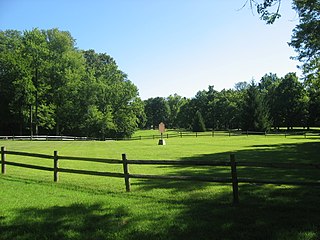
Fort St. Clair was a fort built during the Northwest Indian War near the modern town of Eaton, Preble County, Ohio. The site of the fort was listed on the National Register of Historic Places in 1970.
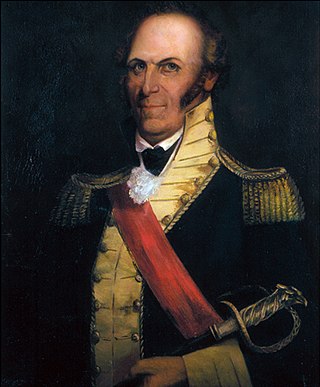
The Blackberry Campaign is the name given to a May 1791 expedition led by Charles Scott against Native Americans of the lower Wabash Valley, primarily Wea, Kickapoo, Miami, and Potawatomi. The intent of the campaign was to demonstrate the vulnerability of Native American villages in the Northwest Territory, to take captives who could be used for peace negotiations, and to keep the forces of the Western Confederacy off balance in preparation for a larger campaign led by Arthur St. Clair. The name Blackberry Campaign was given because soldiers stopped to pick berries to supplement their food supplies.
